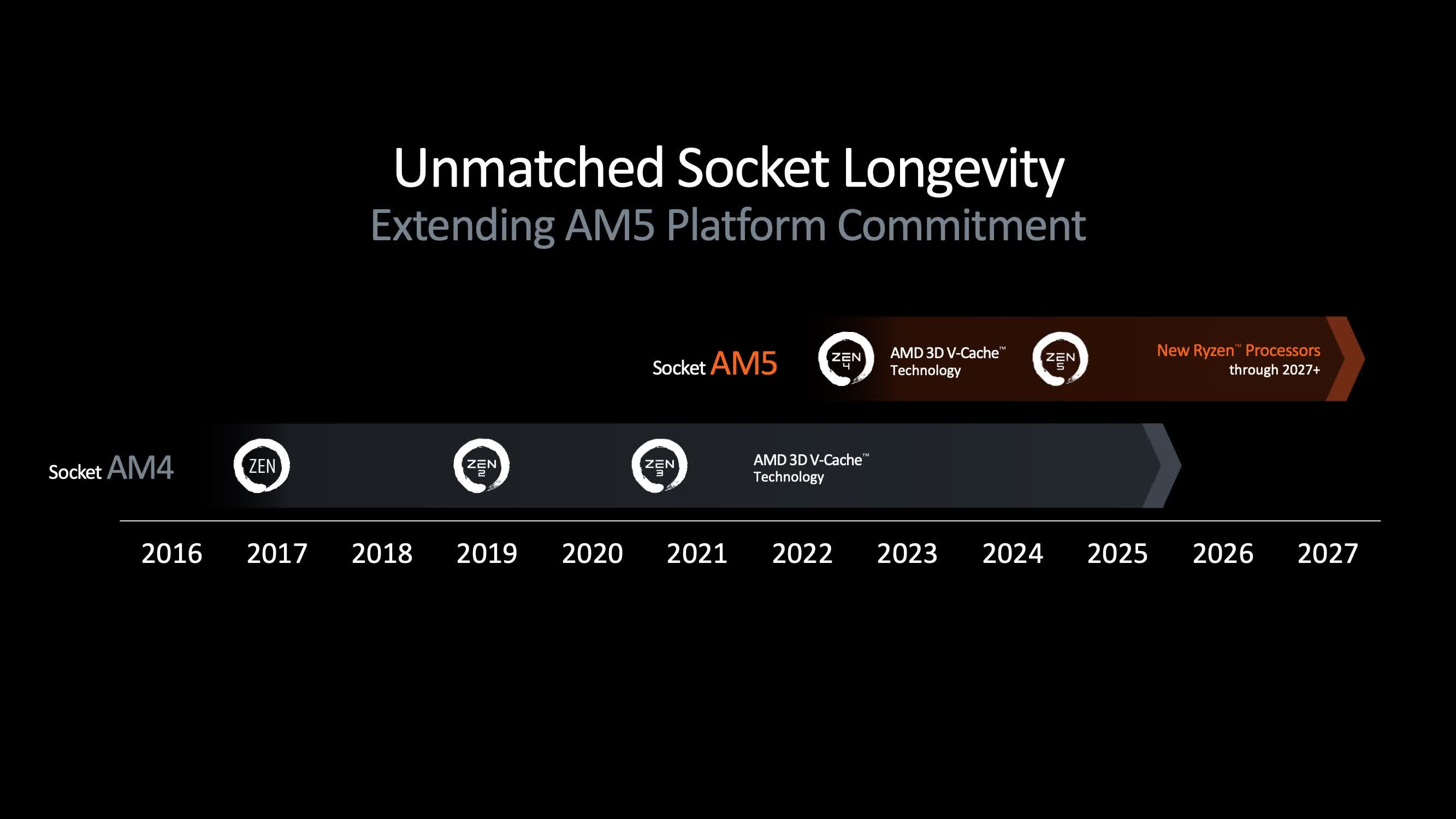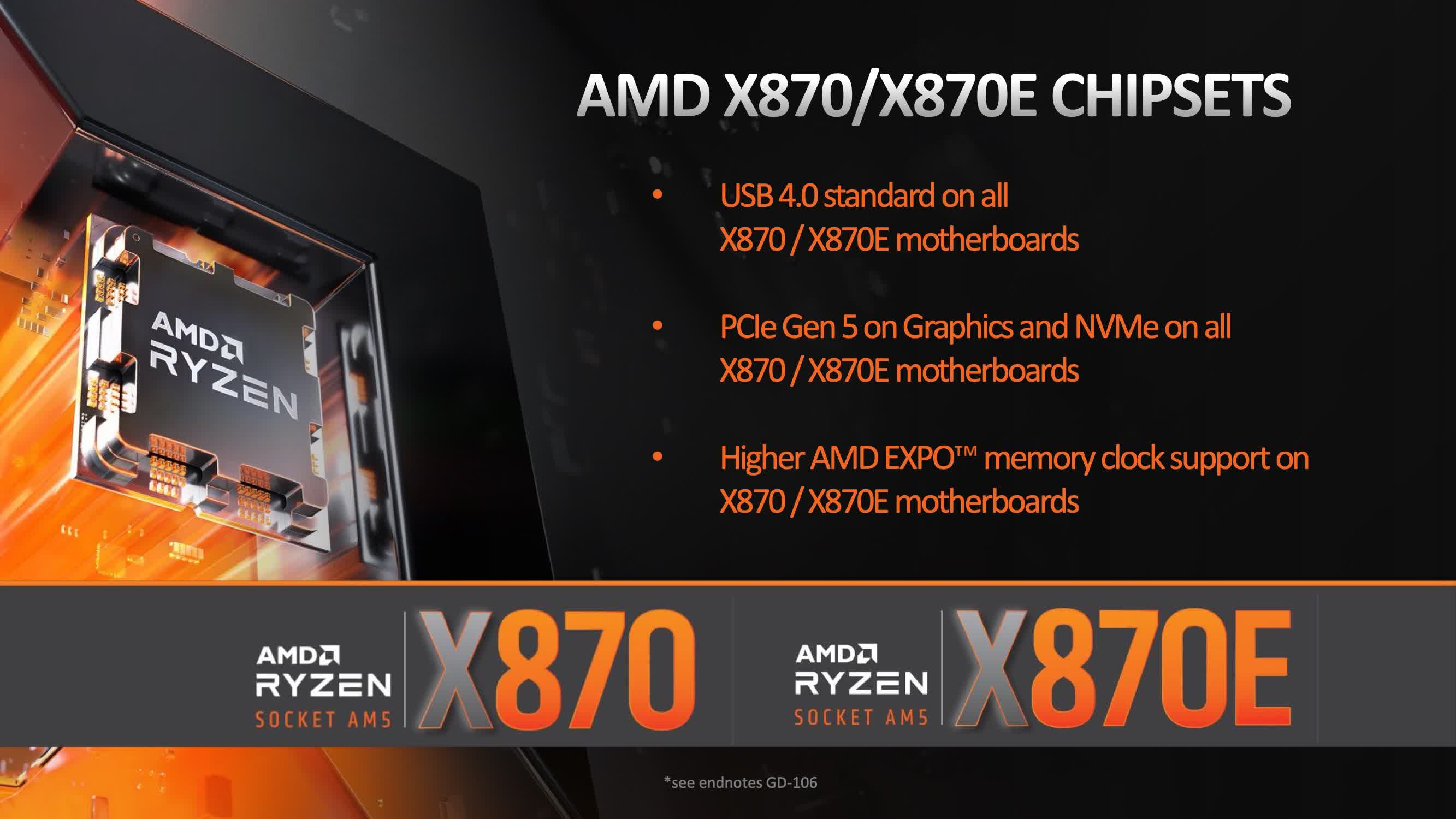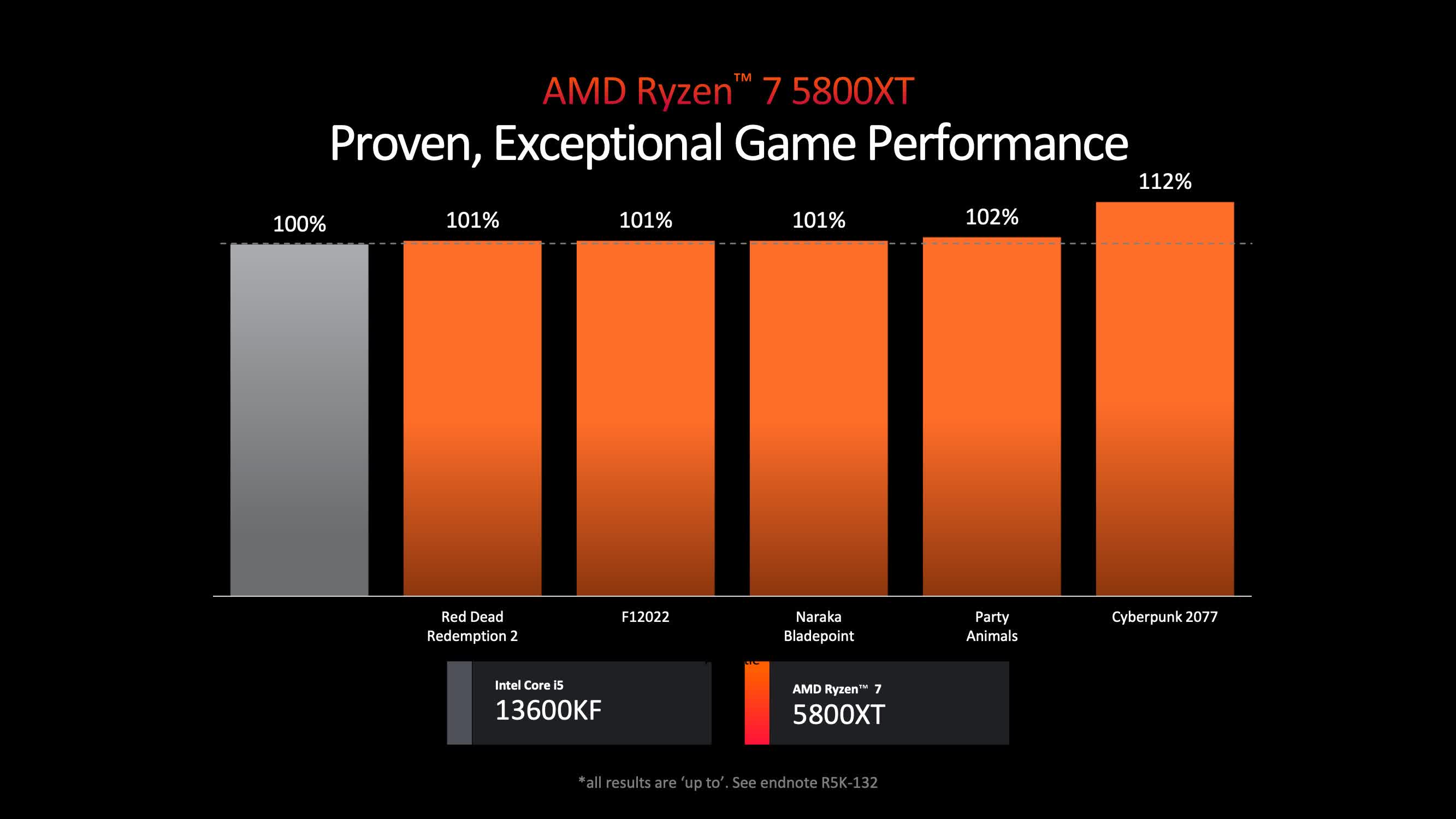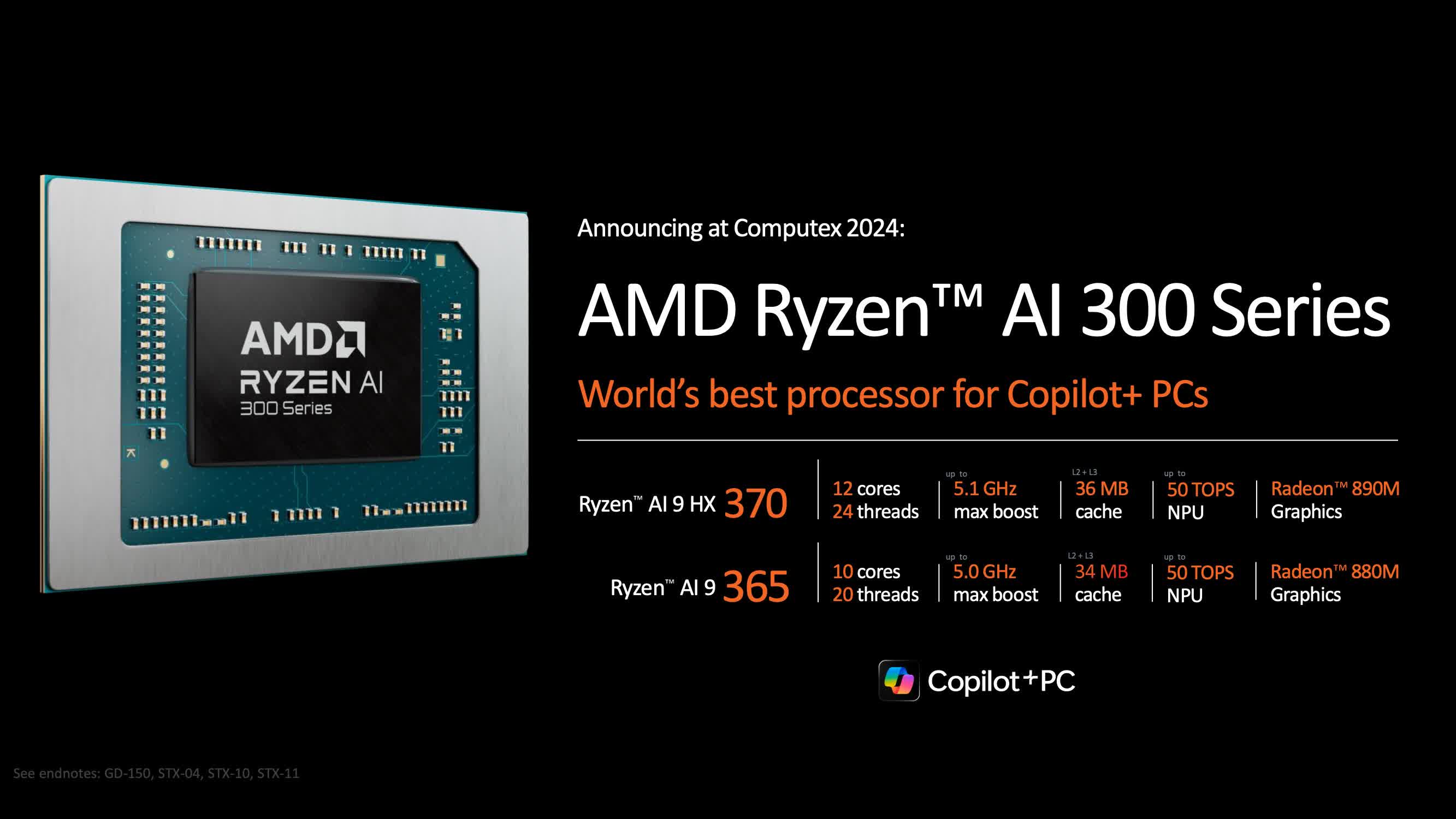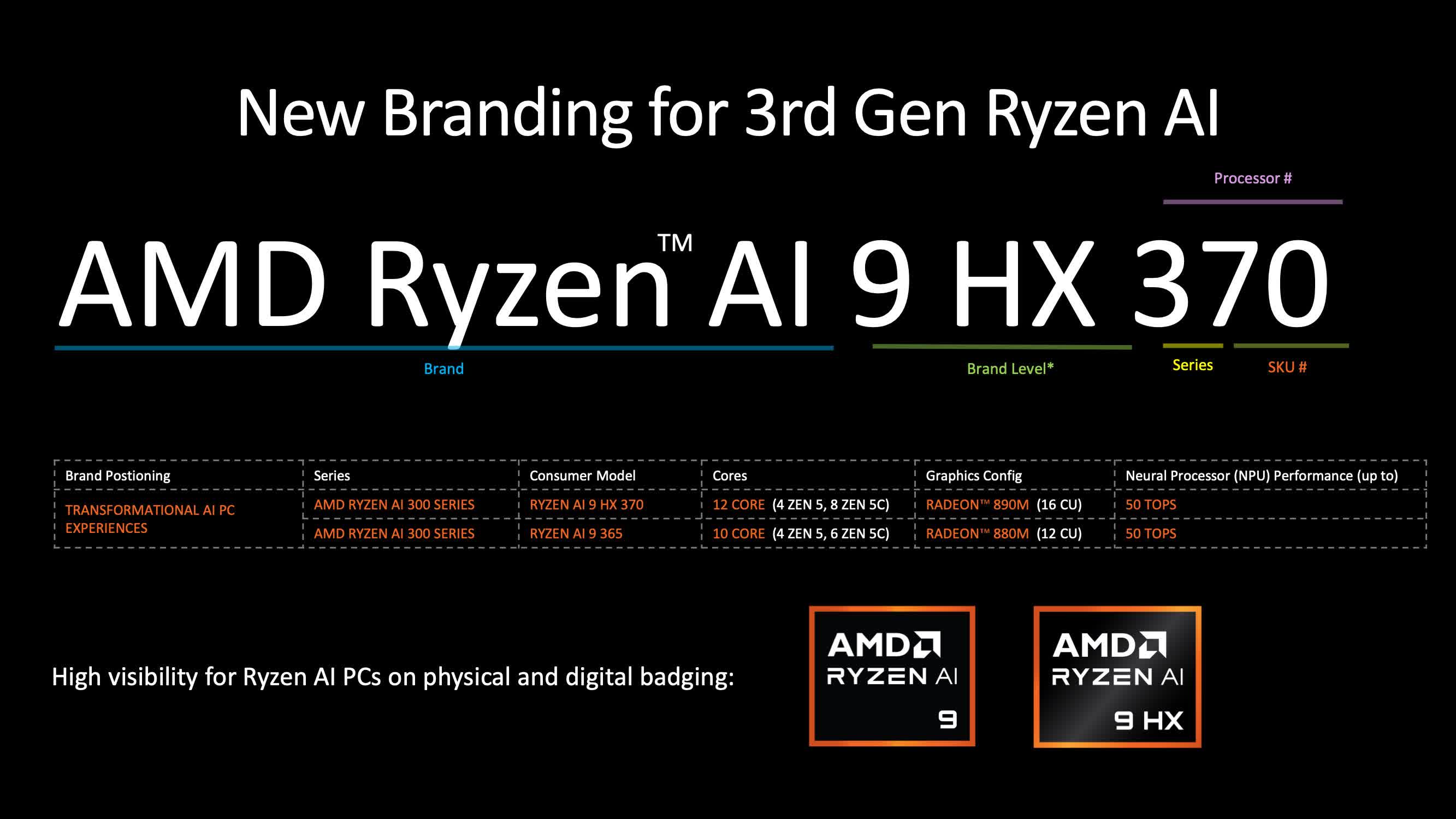Highly anticipated: AMD has announced new Ryzen 9000 desktop CPUs based on the Zen 5 architecture, alongside new motherboard chipsets to support them. Additional details about the AM5 socket and new mobile chips with a heavy dose of AI were also revealed. We were briefed ahead of the Computex keynote, and are now over in Taipei, covering the floor with more coverage to come.
It is now confirmed that AMD is jumping from the Ryzen 7000 series with Zen 4 directly to the 9000 series for Zen 5. The new CPUs, codenamed Granite Ridge, are compatible with the AM5 socket, supporting DDR5 and PCIe 5.0 technologies.
While AMD hasn't provided a deep dive on the Zen 5 architecture just yet, they made it clear that this is a major overhaul to their core design, describing it as a "sweeping update" in contrast to some previous architectures that were more iterative. Zen 5 includes significant improvements to branch prediction, wider pipelines, and deeper window sizes, with AMD claiming up to twice the instruction bandwidth, twice the data bandwidth, and twice the AVX512 throughput relative to Zen 4.
This translates into a claimed 16 percent IPC improvement for Zen 5 over Zen 4 using a geomean. This includes gains of 17% and 23% in common benchmarks like Cinebench R23 and Blender, respectively, though there will be outliers on either side. On the low end, AMD quotes 10% gains, but for specific workloads that leverage certain aspects of the new architecture (such as AVX512), those improvements could be much more substantial.
There's been a lot of speculation around Zen 5's IPC figures lately; we've seen estimates ranging from a 5% gain to some pretty outrageous claims of over 30%. So it's good to finally get some confirmation here. This is a typical IPC gain compared to AMD's previous architectures: Zen 4 versus Zen 3 was a 13% uplift, Zen 3 versus Zen 2 a 19% uplift, and Zen 2 was around the 15% mark over Zen 1 and Zen+. Provided AMD's claims are accurate, this demonstrates a very consistent pace of execution with each major Zen architecture.
However, the total performance improvement from Zen 5 will be limited by clock speeds. This new generation isn't providing significant increases in frequency based on listed specifications for each part, and core counts are identical to the Zen 4 generation. The flagship Ryzen 9 9950X is shown with a 5.7 GHz boost clock, the same as the Ryzen 9 7950X, though we don't know how all-core clocks will fare. This suggests the majority of the performance gains will come from IPC and architectural changes.
In comparison, AMD achieved a 16 percent frequency increase with their Zen 4 flagship compared to Zen 3, which helped raise overall performance. We suspect that in typical workloads, Zen 5 will offer a smaller gain over its predecessor than Zen 4 achieved. This should be more akin to the Zen 3 versus Zen 2 improvement: that generation did not see a significant clock speed increase but did benefit from a large IPC gain.
Part of this is due to AMD using a very similar node for Zen 5 as Zen 4. AMD stated these parts are built on TSMC 4nm technology, which was used for Ryzen 8000 APUs. Ryzen 7000 CPUs with Zen 4 used TSMC's N5 node, and both 5nm and 4nm nodes are part of the same family.
The Ryzen 9000 lineup includes all the models you would expect. There's a 16-core Ryzen 9 9950X, a 12-core Ryzen 9 9900X, an eight-core Ryzen 9 9700X, and a six-core Ryzen 5 9600X.
We don't have pricing for these parts yet, but they will be launched in July 2024, which is not too far away now. All include SMT and similar cache capacities to Zen 4, so the 9700X has 32MB of L3 and 8MB of L2 for a total of 40MB in cache. The 8-core and 6-core models see a 100 MHz frequency increase over their Ryzen 7000 counterparts, while the higher core count models see no frequency gain in terms of max boost.
What has been updated, though, are the TDPs, which isn't a great indication of actual power consumption but does give some idea of how Zen 5 stacks up relative to previous models. The flagship 9950X remains a 170W part, but the 9900X drops to 120W, down from 170W previously. The 9700X and 9600X are now just 65W processors, instead of 105W previously with the 7700X and 7600X. This puts their TDPs much more in line with the non-X models, where both the 7700 and 7600 were 65W parts.
AMD isn't making a ton of performance claims today, but did show some comparisons pitting the 9950X against the Intel Core i9-14900K. For productivity workloads, AMD is claiming notably better performance, such as a 21% gain in Cinebench R24 and a 56% gain in Blender.
Our previous benchmarking had the 14900K and Ryzen 9 7950X neck and neck in most productivity workloads, or in some cases, the 14900K was ahead, like in Photoshop. AMD suggests the 9950X should put them into a clearly superior position, although this is just a comparison to 14th-gen; we are expecting new Arrow Lake processors from Intel in the fourth quarter of the year.
Similarly, AMD is claiming a 13 percent average performance improvement across six games for the 9950X versus the 14900K. Our previous benchmarks using an RTX 4090 at 1080p had the 14900K 10 percent ahead of the 7950X, while losing to the 7800X3D.
We had the 3D V-Cache model coming in around 5% ahead based on a 21-game sample. This implies that Zen 5 non-X3D models should deliver gaming performance around that of the Zen 4 X3D parts, although AMD has tested using a Radeon RX 7900 XTX with both platforms set to use DDR5-6000 memory.
In our game benchmarks, we typically pair the 14900K with DDR5-7200 CL34 memory as it supports higher memory frequencies, which improves gaming performance by a few percent. It's also not fully clear what power profile AMD used for the 14900K on the MSI motherboard they were using; they list the "Intel Default," but this could mean anything these days.
In our game benchmarks we typically pair the 14900K with DDR5-7200 CL34 memory as it supports higher memory frequencies, which improves gaming performance by a few percent. It's also not fully clear what power profile AMD used for the 14900K on the MSI motherboard they were using, they list the "Intel Default" but this could mean anything these days.
Basically, while these numbers can give some indication, they should firstly be taken with a grain of salt as they are likely cherry-picked, and secondly taken with even more skepticism due to the way they've been tested. Hopefully, though, we will see Zen 5 coming out of the gate with highly competitive results.
AM5 platform updates
As for the AM5 platform, there's good news to share, with AMD extending their confirmed lifespan for AM5 through 2027 and beyond. Previously, AMD had only stated support up to 2025+, but that's been extended by at least two years, giving prospective buyers and current AM5 owners more clarity about the future of the platform.
However, we need to be somewhat cautious about what AMD is saying here.
While they are claiming support until 2027+, they are not specifically confirming support for the next CPU architecture beyond Zen 5, which we presume is Zen 6. The reason to be cautious is that AMD, in this same slide, states that AM4 is continuing to be supported today and into 2025, although there's been no new CPU architecture launches on that platform since 2021 if you count the V-Cache models.
So, the least charitable interpretation of this slide would be that AM5 will be supported to 2027+, just with refreshed Zen 5 CPU launches instead of new Zen 6 models.
With that said, we believe the way most people would interpret this, and the way AMD would want you to interpret this, is that at minimum Zen 6 will be supported on the AM5 platform. Marketing the platform in this way strongly implies this, and the implication is stronger now that support has been extended to 2027. Anything short of Zen 6 on AM5 now would be highly misleading given it will almost certainly launch before 2027, so we fully expect Zen 6 to be supported on AM5.
Alongside increased commitment to the AM5 platform, AMD is announcing new 800 series chipsets, X870 and X870E, with AMD deciding to skip the 700 series. Relative to X670 and X670E, these new chipsets bring three key advantages: USB4 support as standard across all motherboards; PCIe 5.0 for both graphics and NVMe storage as standard across all motherboards; and increased memory frequency support through EXPO.
This makes X870 more of an iterative update on X670, though it should raise the minimum capabilities of an X-series board compared to the initial batch of X670 boards. For example, the Gigabyte X670 Gaming X and Asus Prime X670-P are around $200 but only include support for PCIe 5.0 in the first M.2 slot, with PCIe 4.0 support max for the primary x16 graphics slot.
X870 versions of these boards would have to support PCIe 5.0 for both the primary M.2 and x16 slots, as well as integrating USB 4. Interestingly, as part of their briefing, AMD hinted that PCIe 5.0 GPUs are coming soon, which is perhaps a reference to the capabilities of RDNA4.
X870 and X870E boards are, of course, backwards compatible with Ryzen 7000 and Ryzen 8000 CPUs based on Zen 4, though they will also support Ryzen 9000 out of the box. Similarly, existing 600 series boards are forwards compatible with Zen 5, so after a BIOS update, you should be able to drop in a new 9000 series CPU and have it work just fine.
We're also going to have to wait and see what higher EXPO memory clock support actually means. All of AMD's performance data for Ryzen 9000 was captured on an X670E board at DDR5-6000, and there was no mention of Zen 5 actually supporting faster memory. It's possible that it does; we just don't know to what level, whether that memory support will also be possible on X670 boards, or whether these updates to X870 are largely for future-proofing. Expect to see more on X870 as we head to the Computex show floor in the next few days.
More AMD updates: XT CPUs, Ryzen AI mobile parts
AMD is launching the Ryzen 9 5900XT and Ryzen 7 5800XT on AM4 in July, at $360 and $250, respectively. The 5800XT is a 100 MHz overclock of the 5800X, while the 5900XT appears to be a 100 MHz downclocked version of the Ryzen 9 5950X.
Despite its name being "5900," this is actually a 16-core CPU, not a 12-core CPU – though as the 5950X is already available at $360 new these days, the 5900XT makes little sense. The 5800XT makes even less sense as you can pick up a 5800X right now for just $200.
The second half of AMD's presentation largely focused on mobile parts. Key features include an upgrade to Zen 5 CPU cores, RDNA 3.5 graphics, and a new NPU with 50 TOPS of performance, meeting the minimum requirements for Microsoft's Copilot+ PC guidelines.
Some of the interesting things here are the 12-core design in the flagship model, up from 8 cores with their previous monolithic APUs. This is split into four Zen 5 cores and eight Zen 5C cores. The integrated graphics get bumped to 16 compute units, up from 12. These will be available in laptops from various makers beginning in July.
Of course, what we're seeing here is AMD's Strix Point design, not the heavily rumored Strix Halo APU, which is said to increase the CPU design up to 16 cores and the GPU up to a massive 40 compute units. As far as this briefing is concerned, AMD's focus at Computex is on Strix Point and the new AI capabilities it brings because, of course... there has to be mention of AI.
Speaking of AI, the new mobile parts have indeed been renamed to Ryzen AI 300 series, ditching the "Ryzen 9000" branding that they otherwise would have used. This means AMD directly moves from Ryzen 8000 APUs to Ryzen AI 300.
This includes the "Ryzen AI 9 HX 370" and "Ryzen AI 9 365," which are honestly quite bad names that somehow make "Ryzen 9 8940HS" feel like less of a mouthful, a truly impressive feat given the shocking nature of mobile part naming.
AMD has obviously gone with this naming scheme to directly counter Intel's upcoming Lunar Lake, which is expected to be the "Core Ultra 200" series. See, 300 is better than 200; therefore, AMD is better. Oh, and AMD is putting "AI" in the name, so doubly better.
This is the sort of "follower" behavior that AMD seems to love with some product lines, like with their Radeon GPUs that try to come as close to matching Nvidia's GeForce GPUs on price as they can while being slightly cheaper (though usually not by enough).
We don't think following the competition in this way is a clear path to success; AMD should be trying to forge their own path and put themselves into a leader position. Which is exactly what they are doing with Ryzen desktop parts.
Clearly, AMD doesn't care for those CPUs that Intel is likely to go with the Core Ultra 200 brand for Arrow Lake desktop parts. They're sticking with Ryzen 9000 and showing leadership in that market. Changing the mobile naming scheme to follow Intel but also increasing the number from 200 to 300 is pretty uninspiring stuff.
AMD is claiming better performance for the Ryzen 9 AI HX 370 than the Qualcomm Snapdragon X Elite, Apple M3, and Intel Core Ultra 185H.
AMD is claiming better performance for the Ryzen 9 AI HX 370 than the Qualcomm Snapdragon X Elite, Apple M3, and Intel Core Ultra 185H.
In case you're wondering about Radeon, we didn't hear anything significantly new in our Computex pre-briefing. RDNA 4 was not announced, shown off, or even teased – we'll have to see if they ultimately say something about next-gen GPUs during Computex week, though we're not expecting RDNA4 to launch until later this year.
The only Radeon announcement was the Radeon Pro W7900 Dual Slot, which is just a new variant of their workstation W7900 card that's more compact and a bit cheaper.
That's it for AMD's Zen 5 announcement at Computex 2024. Expect our reviews in July, which isn't too far away, and we'll have some hands on time with X870 motherboards in the next few days so stay tuned for that.








